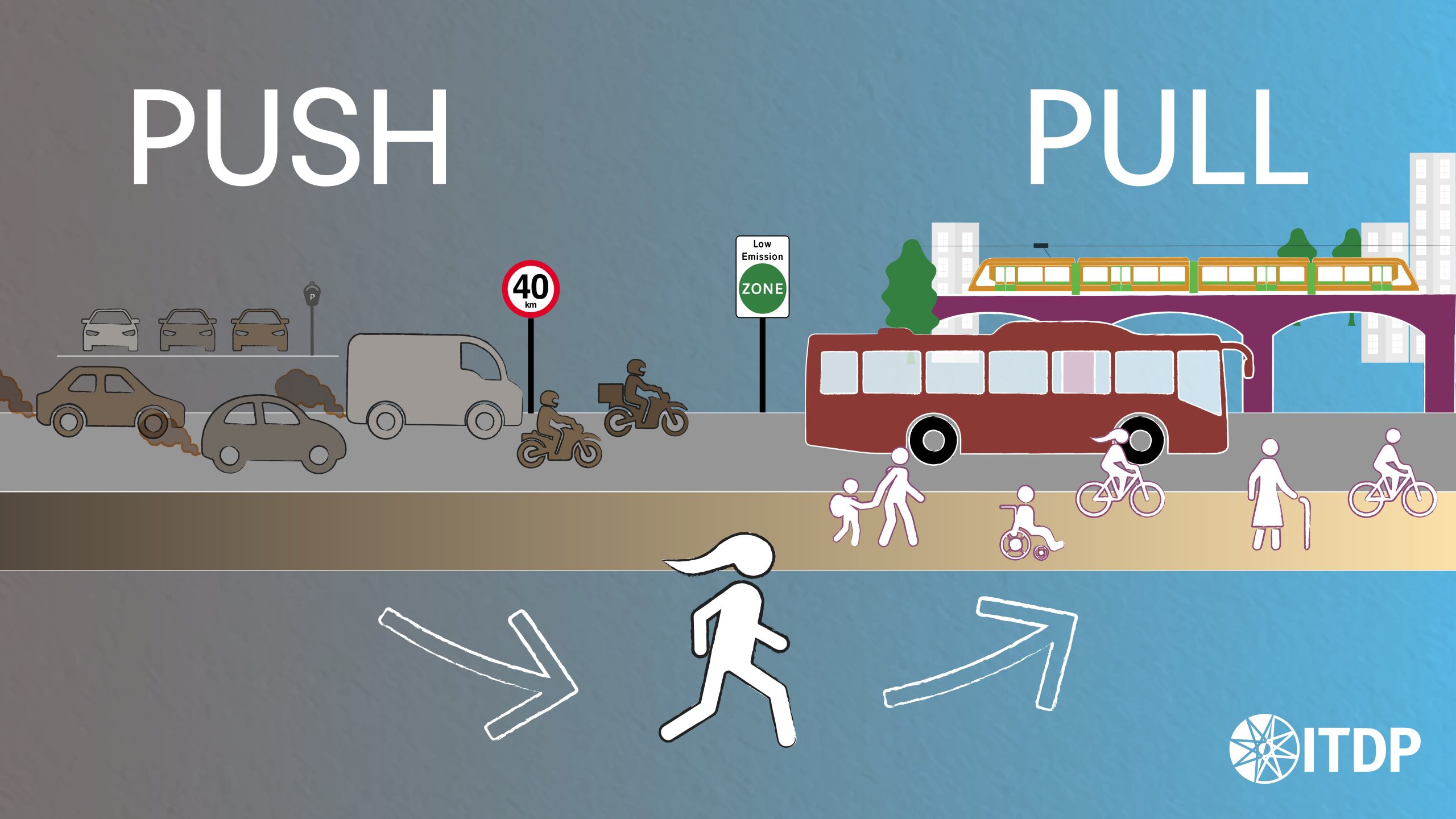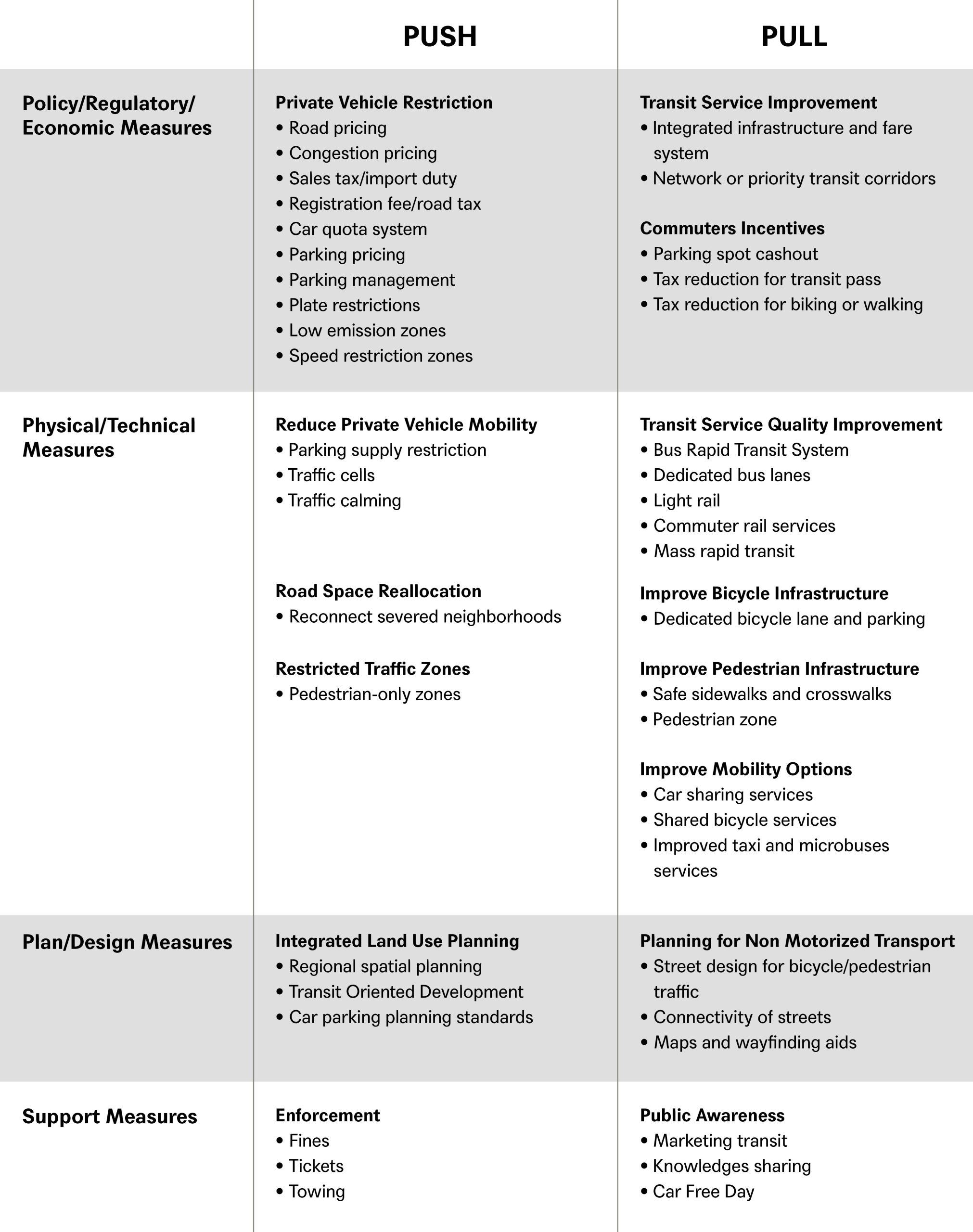June 26, 2023
Transport Demand Management: An Integrated Approach to Solve Traffic Congestion
By: Rahmad Wandi Putra, Transport Associate ITDP Indonesia
Traffic congestion, while faced in cities around the world, still seems an unsolvable urban problem. Even worse, traffic congestion not only hinder mobility but also contribute to air pollution and increase the heat in the city. In Jakarta, recent studies showed air pollution causes more than 10,000 deaths, 5,000 hospitalisations, and 7,000 children experience various health problems every year, costing trillions of rupiah.
In general, imbalance of supply and demand on urban roads creates bottlenecks that lead to traffic congestion. Adding more roads, lanes, or building an overpass have been long considered a straightforward solution to ease traffic. It is also a typical approach used by many cities in Indonesia and even the national government. As can be seen in the diagram below, 8.1% of national expenditure related to infrastructure is allocated to road development while only 2.8% is for land-based and railway-based public transport1.
![[ENG] Editorial Illustration - TDM & ERP Article -02](https://itdp-indonesia.org/wp-content/uploads/2023/06/ENG-Editorial-Illustration-TDM-ERP-Article-02.png)
National infrastructure budget allocated 56.3% for road and bridges infrastructure, while only 29.5% was allocated to land-based and railway-based transport2.
![[ENG] Editorial Illustration - TDM & ERP Article -03](https://itdp-indonesia.org/wp-content/uploads/2023/06/ENG-Editorial-Illustration-TDM-ERP-Article-03.png)
Nevertheless, road expansion will trigger the generation of new vehicle trips (i.e. induced demand). This phenomenon is more intuitive than it seems, because as a rule more people will drive as driving becomes faster and more convenient when the new road is (still) empty. But in the long run the newly constructed roads will also encounter congestion, as has been observed in multiple cases3,4.
A similar issue also happens in parking provision. Adding more parking spaces in the city center will generate more private vehicle demand, because it will improve the convenience to access the area by using cars or motorcycles. Without any measures to control demand, there will still be a possibility of parking inadequacy due to the increasing dependence to cars and motorcycles.
Furthermore, we can argue that adding road, lanes, and parking spaces will stimulate urban sprawl considering two reasons: 1) the decreased land availability in city centers due to excessive road and parking facilities expansion can make affordable housing provision more difficult, and 2) increased convenience to use cars and motorcycles encourages people to commute further. On the other hand, the further people need to travel, they will be more dependent on automobiles5. This approach is often fruitless to address congestion, and instead causes a never-ending vicious cycle.
![[ENG] Editorial Illustration - TDM & ERP Article -01](https://itdp-indonesia.org/wp-content/uploads/2023/06/ENG-Editorial-Illustration-TDM-ERP-Article-01.png)
In order to break this cycle, there should be a shift of approach from supply-oriented interventions into demand management. This approach is well-known as Transportation Demand Management (TDM) which aims to reduce the private vehicle dependency and promote the shifts toward more sustainable modes of transport. The approach requires implementing both incentives to public transport (“pull strategies”) and disincentives to private vehicles (“push strategies”), which is often missing from a city’s transport strategies. Not only this holistic approach has been shown to be more effective to shift people to public transport, walking, and cycling and promote efficient land use by creating a compact and vibrant urban land use and communities, the implementation of push policies can also be a more cost effective solution by unlocking new revenue source to improve public transportation services.
This is not to say TDM approach implementations will be easy and straightforward. Depending on pull strategies only, such as constructing a heavy-rail infrastructure or improving pedestrian and bicycle infrastructure only, might result in little shifts from private to public transport. Meanwhile, relying to push strategies only, such as increasing fuel tax or imposing road pricing without providing public transport options can create public uproar and stimulate disparity. A comprehensive TDM strategy requires a balance of improving mobility options, private vehicle disincentive measures, and smart growth and land use policies.
Several cities have already implemented a comprehensive TDM strategy to solve their congestion problem. In 2007, Stockholm, Sweden, introduced congestion tax (which is a push strategy) in its central area. There was a major rejection by the public but the government mitigated the problem by improving its bus services to accommodate the affected drivers (a pull strategy). As a result, there was an increase of 10-15% in bus ridership to the central Stockholm area and the overall traffic volume decreased by 20%. In addition, the Swedish government generates a new source of revenue which then is earmarked to improve Stockholm’s transportation infrastructure.
Another example of successful TDM measures implementation can be seen in Singapore. Even prior to the renowned Electronic Road Pricing (ERP) scheme, started in 1998, Singapore had implemented several push and pull strategies to combat traffic congestion in its tiny island. The Area License Scheme (ALS) and Vehicle Quota System, (another push strategy) was implemented respectively in 1975 and 1990 to restrict vehicle usage and growth8. On the pull strategy side, besides expanding its bus and railways system (MRT and LRT system), Singapore successfully implemented an integrated public transport payment system to avoid hassle during changes between buses, MRT, and LRT. The payment system has now been upgraded several times, from a card-based offline card in 2000s into account-based online started in 20179.
The array of push and pull TDM measures can be seen in the table below (Broaddus,2006), categorized into policy/regulatory/economic measures, physical/technical measures, plan/design measures, and support measures.


In Jakarta, TDM approach has been applied to counter traffic congestion through several push and pull measures. In 2003, the government introduced a “3-in-1” scheme, a push strategy where only High Occupancy Vehicles (HOV) with at least three people, including the driver, shall be allowed to pass through certain corridors. However, the measure was not effective because of the emergence of 3-in-1 jockeys. The policy was altered into Odd-Even License Plate Restriction in 2016. The restriction is still in effect until now but studies have shown10 that the policy triggers an increase in the number of vehicle ownership in one household. Currently, the Government of Jakarta is formulating the policy on road pricing through ERP scheme as an improvement to the odd-even restriction measure.
On the pull strategy side, the government started operating the first Bus Rapid Transit (BRT) line in 2004 which has expanded into 251 km in length. The first MRT line operated in 2019 and will expand to cover both North-South and East-West trips. In 2020, the Government of Jakarta implemented the fare integration system under JakLingko which offers incentives for citizens to commute or travel around Jakarta using public transportation. There are also other efforts such as sidewalk and cycling infrastructure expansions to promote non-motorized first-last mile connections from and to the transit points.
Implementation of TDM is not only relevant for Jakarta, but also for other cities in Indonesia too as traffic congestion increasingly becomes a universal problem. Learning from Jakarta, cities should take a leap in acknowledging that road expansion, including inner city highway development, is not an effective nor appropriate approach to tackle or prevent traffic congestion and mitigate other economic, social, and environmental loss due to excessive cars and motorcycle usage. Allocating more investments to public transit and non-motorized transportation access, along with implementing measures to disincentivize private vehicle usage such as by improving parking management, is the only way to go towards better traffic and sustainable transport development.
—————————————-
1The data obtained from APBN 2023 with rough estimation taken from the Ministry of Public Works and Public Housing and the Ministry of Transportation. The estimation was based on the historical data that at least 85% of the allocated budget to the Directorate General was used for capital spending
2The data obtained from APBN 2023 with rough estimation taken from the Ministry of Public Works and Public Housing and Ministry of Transportation. The estimation was based on the historical data that at least 85% of the allocated budget to the Directorate General was used for capital spending
3Duranton, G., & Turner, M. A. (2011). The fundamental law of road congestion: Evidence from US cities. American Economic Review, 101(6), 2616-2652.
4Hsu, W. T., & Zhang, H. (2014). The fundamental law of highway congestion revisited: Evidence from national expressways in Japan. Journal of urban economics, 81, 65-76.
5Iacono, M., Krizek, K., & El-Geneidy, A. M. (2008). Access to destinations: How close is close enough? Estimating accurate distance decay functions for multiple modes and different purposes.
6Broaddus, A. et. al. (2009). Transportation Demand Management Training Document. GTZ
7TDM Success Stories – Examples of Transportation Demand Management Policies and Programs, and Keys to Their Success (2023) https://vtpi.org/tdmss.pdf
8Goh, M. (2002, March). Congestion management and electronic road pricing in Singapore. Journal of Transport Geography, 10(1), 29–38. https://doi.org/10.1016/s0966-6923(01)00036-9
9SimplyGo with new transport payment option. (2019, April 4). SimplyGo With New Transport Payment Option | the Straits Times. https://www.straitstimes.com/singapore/transport/lta-launches-digital-payment-scheme-for-public-transport
10Tinumbia, N., & Khotimah, K. (2021). The Impacts Of Odd–Even Restriction Policy On Travel Behaviour. Jurnal Infrastruktur , 7(1), 21 – 28. https://doi.org/10.35814/infrastruktur.v7i1.2079
